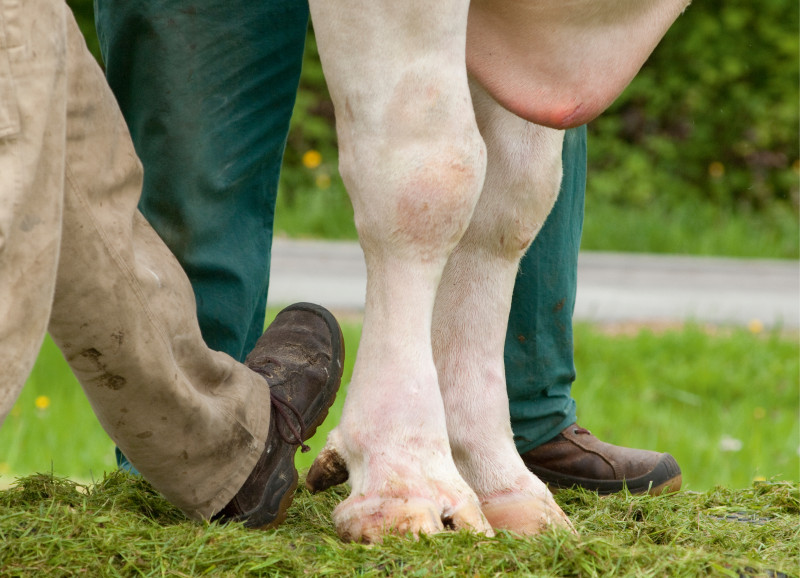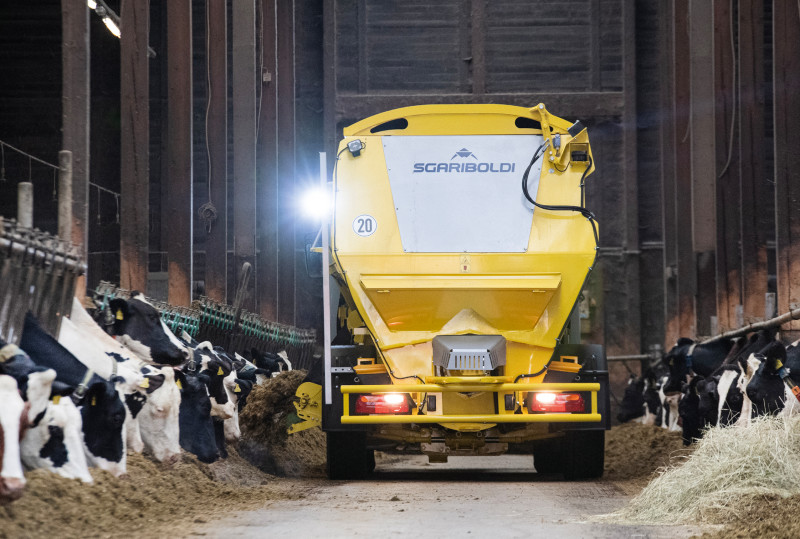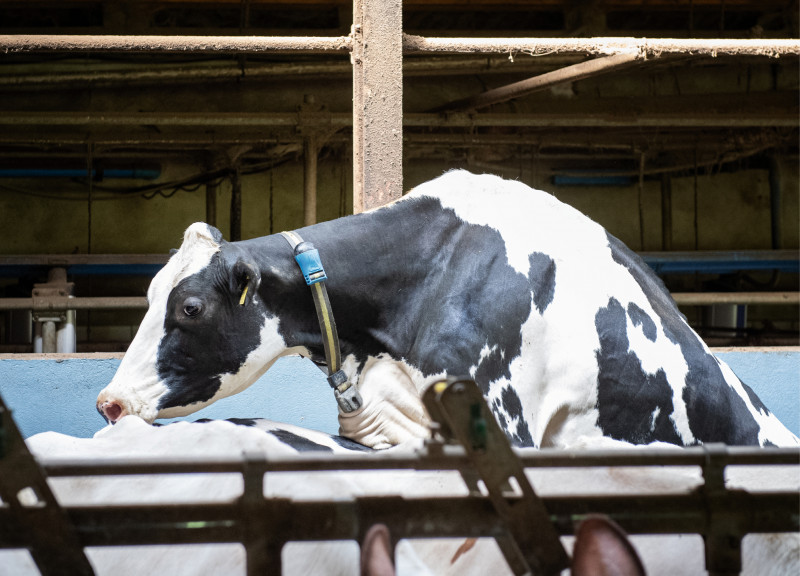
In the German language, the term “foundation” is used for feet and legs. With a house, the foundation gives the construction the required stability to last for a long time. The same is true for a cow, though with a decisive difference: the foundation for the cow is also her means of transportation. As such, the challenge for its functionality is so much bigger.
JACQUES BERNARD, HAN HOPMAN
Someone who knows a lot about hoof health is Antoine Janssen. For over 20 years he was a passionate dairy farmer and breeder in Luxembourg, before striking out on his own as a hoof trimmer in 1997. Since then, he has participated in countless courses and projects, and for almost 18 years he has been training new hoof trimmers internationally. Right from the start of the conversation it was clear how much worth Janssen places on tying theory and practice together and that it is still important to him to continue working on farms himself. ‘As a teacher, one must never lose touch with the practical reality, otherwise we cannot offer a quality and high-value education,’ is Janssen’s motto. Another point that is important to him is to have an overview of the entire situation.
DRAW A PICTURE
‘When I drive to a farm, I try to get an overall picture then I break things down from big to small and analyze the circumstances. When I draw a picture of the farm, the barn, the herd and finally the individual cow, then I can, with a high probability, predict how the hooves will look,’ explains Janssen of his approach, which he tries to pass on in just this manner. To only focus on trimming and handling when it comes to hoof care would be short-sighted, as hoof health is a multi-factorial topic. Every cow is evaluated before trimming, with the focus being on age, weight, body condition, leg angle and placement as well as the thurl position. These traits explain how the cow moves, how the weight is distributed and what the wear on the hoof is. ‘For rear leg angle, five is the optimum in the linear description for hoof wear. Every deviation from this leads to the weight of the cow not being optimally distributed across the entire hoof. Straight legs in particular are quickly becoming more prevalent on the farms, which results in the tips of the hooves being overly stressed. Another topic is chest width. Holsteins today are often too narrow and have twisted front legs, so the hooves don’t wear properly and the live tissue within the hoof is displaced,’ warns Janssen. However, genetics is only one part of the whole and in practice he can see that cows with poor genetic disposition for legs still perform well in herds with good management. The interim conclusion is that overall hoof health comes and goes with management.
‘Hoof health comes and goes with management.’
SETTING THE RIGHT PRIORITIES
Management is a complex term, which encompasses housing, feeding, water, comfort and hygiene. According to Janssen, well managed herds have one thing in common: they set the right priorities and have the desire to continue developing. ‘Organization and documentation are important for both the farm and the hoof trimmer. With farms getting bigger, we do fewer visits to trim an entire herd, but rather more regular visits to work with specific animals. That requires more planning, though the routines become less stressful for the people and the animals because working together becomes more routine,’ says Janssen. The hoof trimmers work with codes that describe and document the findings from each hoof. These codes are the same in 43 countries around the world and allow better exchange and comparison of data. The most common findings are laminitis, foot rot, digital dermatitis and limax. Prevention is an important aspect, which is why the Locomotion Score (an evaluation of the movement of the cow on a scale of one to five) should have much more importance. ‘The newest findings show that very few farmers would classify a cow with a Locomotion Score of three as lame, and as such these cows do not receive the required care, though they are often already suffering from considerable loss of production. If we manage to identify these animals in a timely manner and care for them, then we would have much less acute lameness in the future,’ Janssen is convinced. In his opinion, optimal hoof health would look as follows: first trimming at breeding age of 14 to 15 months, second trimming about six weeks before first calving and subsequently in every lactation at around 100 days in milk and before the dry period. Handling of problem animals should be done as quickly as possible and in the interim Janssen welcomes every form of hoof bath, mat or other measures that improve hoof health, as long as they are done regularly and hygienically. ‘We cannot forget that the cow is meant to walk on soft ground and that under today’s housing conditions we have to take great care of their locomotion. Furthermore, we always need to keep in mind that hoof health is not only a discussion of profitability, but also of ethics and animal welfare!’ he concludes.
TARGETED CARE
Improving animal welfare is also the mission of Intracare, one of the world’s leading companies for hoof care. ‘Our core focus is to maintain the hoof in good condition. To remain competitive, as a company we must continually improve in three areas: product development, technological application and environmental awareness,’ explains Marc Spackler, the Technical Sales Manager of Intracare. The newest development is a patented concept, the Intra Precision Sprayer, which directly and very precisely sprays the hoof. The laser technology is by now so well developed that it can exactly detect where the spray must be applied. The advantage of this is that clean product is always applied to the hoof and that the amount of product which is used can be reduced. ‘Prospectively we will only require 10 to 20 percent of the amount as we can be sure that up to 90% of it makes it to the exact spot where it is required,’ Spackler continues. The reduction in the amount of product used benefits both the profitability and the sustainability of the farm. The Spot-Spray System is installed in either the robot or parlour and, depending on the programming, applies a preventative treatment once or twice a week to further hoof health which is automatically and diligently executed. On the occasion of this year’s Eurotier, Spot-Spraying was nominated for an Innovation Award. Another interesting product in the lineup is the Intra Eco Tape. This is a wrap with good flexibility, adhesive and removal characteristics, while being up to 95% degradable and as such is quite environmentally friendly.
ENVIRONMENTALLY AND CONSUMER FRIENDLY
Through their daughter company AgroChem USA, the French company Kersia also offers numerous products for hoof care. ‘We have a variety of chemical solutions for agricultural operations, including for hygiene, feed production, and udder and hoof health. The latter products are integrated under the Healmax® product line and offer dairy farmers many possible uses,’ shares Todd Raymond, Sales Manager at AgroChem USA. The goal of the product line is high effectiveness combined with maximum environmental and consumer friendliness to keep hoof problems like digital dermatitis under control. ‘For example, for hoof baths we have developed a concentrate without formaldehyde. This has several advantages, the primary one being that its use is safer for farmer and animal, and its application is effective in both warm and cold temperatures. As such, we are able to offer customers a solution in regions where there are restrictions or bans on the use of products with formaldehyde,’ Raymond continues. To ensure diligent implementation of a foot bath, AgroChem also offers an automatic dosing system. This helps avoid human mistake and ensures that the hoof bath is prepared even during more stressful periods of work. While the preventative measures for lactating animals are often carried out, heifers and dry cows are often overlooked for various reasons. As such, AgroChem developed the Healmax® Foam, which can easily be applied to the hooves while the animals are locked at the feed bunk. This makes it possible for farms to implement preventive care in all groups without having to have a hoof bath in every barn or having to move the animals over longer distances.


